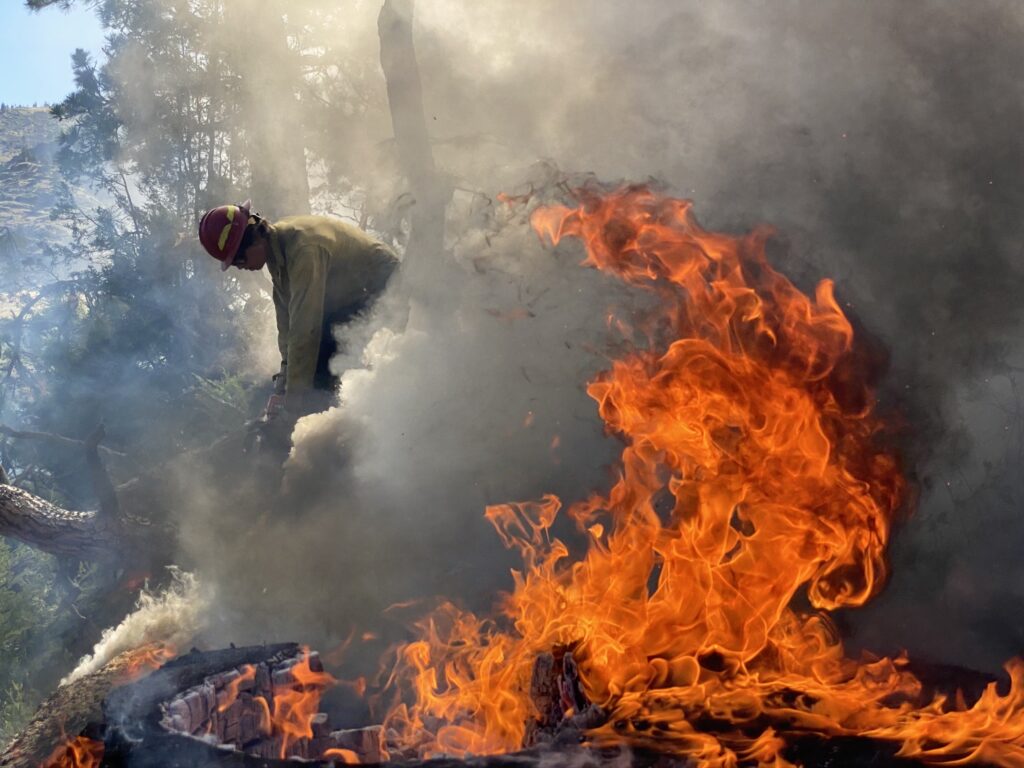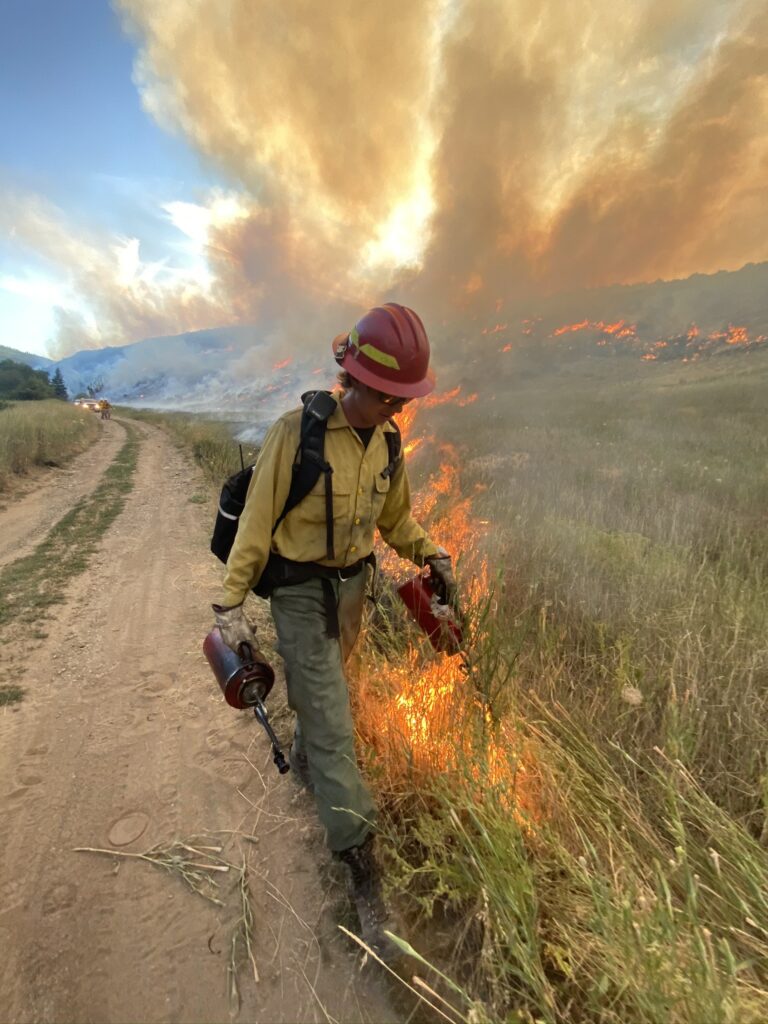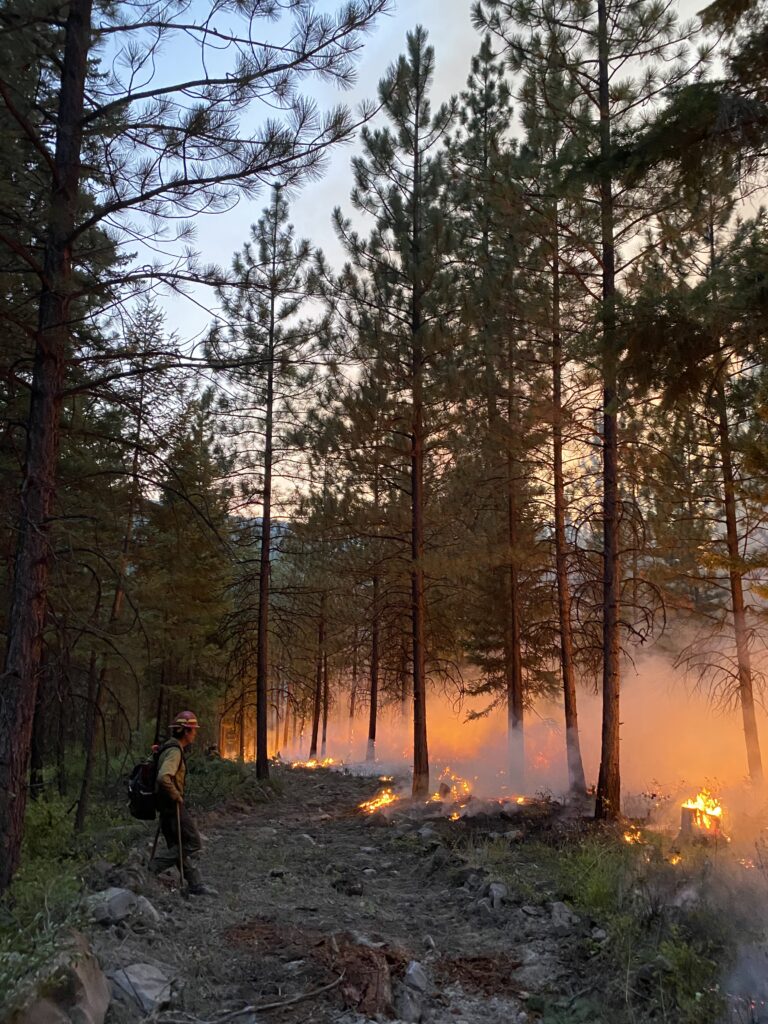Salish Kootenai College’s new graduate program in natural resources emphasizes fire ecology
By Melanie Lenart

After an early start to fire season in New Mexico and Arizona, the American West is bracing for another season of out of control blazes. Tribal forestry experts blame both climate change, which is making the region both hotter and drier, and a century-old approach to fire fighting that has turned many forests into tinderboxes.
“We’re seeing a lot of different things here kind of all coming to a head right now,” explained Ron Swaney, a fire management officer with the Confederated Salish & Kootenai Tribes’ fire division. Climate change, fire suppression and a lack of understory burns contribute to the risk, which is greatest in the urban interface area—“where the roofs meet the trees.”
“And we’ve got quite a bit of that, actually,” he said, referring to the urban interface on the tribes’ 1.3 million-acre Flathead Indian Reservation in Montana. While his division falls under tribal offices, its funding comes from the Bureau of Indian Affairs. Swaney interacts with fire employees from other tribal nations in the West on a regular basis and knows firsthand that they’re all dealing with similar problems, which are also exacerbated by staff shortages.
New college program tackles complexity
It’s a challenge for managers of fire, wildlife and natural areas to deal with the many changes underway, much less prepare for the even hotter future many natural resource professionals will see in their lifetimes. Salish Kootenai College is seeking to help these working professionals and other college graduates in the sciences meet these challenges with a new online graduate degree: a master’s of science in Natural Resource Management.
Rick Everett, a longtime faculty member at the college and project director for the $2.5 million National Science Foundation grant supporting the new degree, said he has been developing the program’s curriculum with the intent of helping to prepare resource managers for the ongoing changes. “The people that we’re training now are the people who are going to be making the hard decisions in 25 years,” Everett said. Judging from climate change projections for 2050 and consistent underfunding of potential solutions, wildfire threats to ecosystems and homes will only get worse in the next quarter century.

Everett hopes the program will help resource managers get in front of the threat by providing a well-rounded education that weaves in fire ecology alongside other topics, including climate modeling, forestry, wildlife biology, fisheries and hydrology. He partnered with other fire ecologists at University of Idaho to develop the program, and the university is sharing curriculum and other resources. The distance learning courses will run synchronously in quarterly sessions, allowing students from around the country to interact in real time with instructors and each other.
Fire became a “big passion” of Everett’s in the 1970s, when he started working seasonally fighting fires. In the 1980s, he moved on to fire ecology work at the University of California Berkeley before returning to his native Montana about 12 years ago to teach at Salish Kootenai College. He encourages students in the program to work seasonally in their fields.
Students would be welcome to sign on as seasonal employees with the Confederated Salish & Kootenai Tribes. Like a variety of agencies throughout the West, the fire division is currently facing a labor shortage.
“There’s just not enough people to manage the types of fires the western United States are having now,” Swaney said.
Spreading like wildfire
Wildfires have gotten bigger since the 1980s, burning far more acreage and for longer durations, according to research at the University of California Merced. What’s more, the length of the fire season has expanded by 60 percent, from an average of 138 days in the 1970s to 222 days in the 2010. The researchers found the increase especially striking in the northern Rocky Mountains, which run through Montana, in years when the snow melted earlier than usual.
The repercussions for natural resources such as soil, water and plants go far beyond the fire season. Wildlife biology often comes down to managing vegetation—known in that community as habitat—and vegetation is affected by fire. A hydrology student who started the program last year was amazed to realize how much wildfires affect streams for years after the burn, Everett said, including from heavy sediment loads as soil erodes off the fire-stricken landscape.
Sierra Mahseelah is the college’s graduate student success coordinator and also a student in the new program. She said her passion involves plants and the information about them incorporated into the Salish language—which she speaks, thanks to an intensive program while working for the Séliš Ql̓ispé Culture Committee. Still, she appreciates the program’s emphasis on fire ecology because she understands the importance of fire for the plants she loves.
“Far back in history you can see the tribal communities regularly burned places to keep the habitat, to keep the plants happy, to keep everything in balance,” she said. “And then when the federal government told them they couldn’t do that anymore, that forest fires were bad and they had to stop, it just got so overgrown and now you have these large areas that just are waiting to go up.”
Fire-dependent ecosystems
As fire historian Stephen Pyne explains, Europeans immigrating to this continent were accustomed to wetter forest types that rarely faced fires.
In 1910, when a series of big fires known as The Big Blowup devastated Montana, Idaho and Washington, the five-year-old US Forest Service coalesced around a mission of suppressing fires. At the time, Forest Service Director Gifford Pinchot squelched the urging of some farmers and even Secretary of the Interior Richard Ballinger to burn the landscape annually “like the Native Americans did.”
In the 111 years since the August Blowup, the Forest Service has generally continued its efforts to suppress fire. The policy, along with warming temperatures and other factors, has spurred trees and shrubs to invade grasslands. It also has altered many ecosystems, particularly those that evolved with frequent fires.
For example, Ponderosa pine forests evolved thick bark to withstand the small fires that would sweep across the forest floor once or twice a decade, fed by the needles they discarded. Due to fire suppression, the smaller trees that would have died in these mild fires grew tall enough to carry flames into the canopy of the overstory Ponderosa trees. Now when a fire starts—a natural occurrence in the West when lightning strikes during the dry season—it can get so big and hot that it kills even these fire-tolerant stands in expanses stretching thousands of acres.

“It’s a fire-dependent ecosystem and this ecosystem evolved with fire, as did the animals, the birds, the plants and everything else associated with it,” said the fire division’s Swaney, an enrolled member of the confederated tribes. In their creation story, the animals gave their ancestors fire to use for the benefit of all. “You’d be amazed at how many birds, plants, bugs, are dependent on fire.”
Some of the tribes’ most culturally significant plants, such as huckleberries and camas, are early successional species that flourish in the wake of fire, he explained. People traditionally ate the licorice-flavored camas bulbs after wrapping them in skunk cabbage and moss and baking them in a pit for several days. The Salish traditional calendar features some of these plants, as a modern means of connecting members to the cultural ways of their people.


Bringing fire back to the landscape
After erupting earlier this spring in the Southwest, the fire season will move north into Montana in June or July as hot summer days preheat forests that lack rainfall for more than a few weeks, priming them for roasting by wildfires.
At this time of year, Swaney and others in the tribes’ fire division are striving to reintroduce the balm of prescriptive burns, a medicine applied by tribal nations for a variety of reasons during their long tenure on these lands. Still, modern conditions make this effort far more challenging than it was in the days when their ancestors used fire as a tool to revive their favorite plants, clear brush and improve browsing for elk and bison.
For one thing, all those years of fire suppression have allowed the buildup of small trees, deadwood and brush—known to fire workers as fuel.
“Pretty much anyone you talk to in fuels or fires will tell you there’s constantly an increase in fuel loading in our woods,” said Darrell Clairmont, a prescribed fire and fuels manager for the tribes. Because of this, he and others often must clear out small trees before they can risk setting a fire in a treasured forest or near an urban interface.
As Swaney noted, “You just don’t want to flip a match out there and hope everything turns out well.”
High winds are another issue because they can carry fire more quickly. They are usually involved in the small proportion of fires that resist control, such as The Big Blowup of 1910, and the New Mexico wildfire that, by mid-May, already surpassed 200,000 acres. The latter started as a prescribed burn on April 6.
Unusually windy spring weather for the past several years has limited the Salish Kootenai division’s ability to carry out prescribed burns.
Swaney was enthusiastic about what Salish Kootenai College’s new graduate degree could mean for the many western tribal nations trying to maintain plants, wildlife and commercial ventures involving natural resources as the climate continues to heat up and trigger uncontrollable wildfires.
“Anything we can do to give more of a unified approach to our management strategies is critically important for us right now,” he said. “We need people who understand today’s environment, not yesterday’s environment.”
Potential students interested in the program can contact Sierra Mahseelah at sierra_mahseelah@skc.edu. Applications are due in October for the winter quarter.

Melanie Lenart is a regular contributor to Native Science Report.
• • •
Enjoyed this story? Enter your email to receive notifications.
